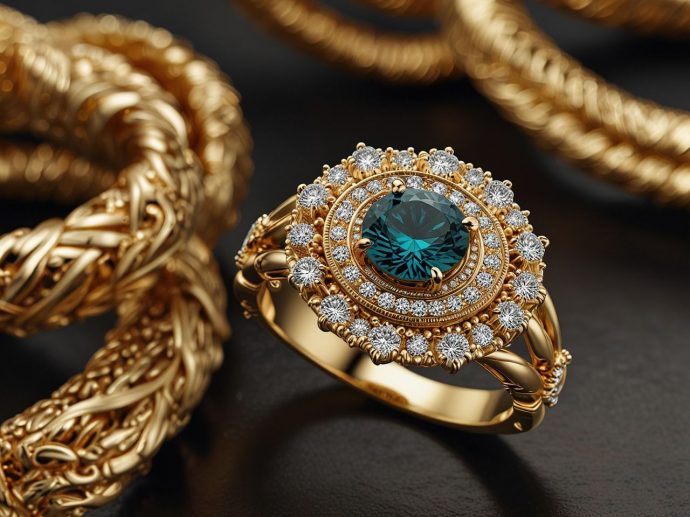Categories more
- Adventures (17)
- Arts / Collectables (15)
- Automotive (37)
- Aviation (11)
- Bath, Body, & Health (77)
- Children (6)
- Cigars / Spirits (32)
- Cuisine (16)
- Design/Architecture (22)
- Electronics (13)
- Entertainment (4)
- Event Planning (5)
- Fashion (46)
- Finance (9)
- Gifts / Misc (6)
- Home Decor (45)
- Jewelry (41)
- Pets (3)
- Philanthropy (1)
- Real Estate (16)
- Services (23)
- Sports / Golf (14)
- Vacation / Travel (60)
- Watches / Pens (15)
- Wines / Vines (24)
- Yachting / Boating (17)
His & Hers: The Art of Selecting Harmonious Ring Designs
Published
07/06/2025Finding two rings that speak to different personalities while maintaining visual harmony requires more than matching metals. The perfect pair should reflect both unity and individuality—a tangible representation of how two distinct styles converge. This delicate balance between coordination and personal expression transforms wedding bands from mere accessories into meaningful symbols of partnership.
Establishing a Common Language Through Materials
When blending modern and vintage ring designs, metal choice becomes the unifying thread. A 1920s Art Deco engagement ring with platinum filigree might pair beautifully with a contemporary band in the same metal but with clean, architectural lines. For mixed-metal combinations, consider having one element echo between both rings—perhaps rose gold accents on white gold bases, or hammered textures that appear in different patterns. This creates continuity without demanding perfect symmetry.
Contrasting Eras with Intention
Deliberate juxtapositions often yield stunning results. Try matching an ornate Victorian-era band with a minimalist modern counterpart that shares similar proportions. The contrast highlights each ring's unique character while establishing visual balance. Alternatively, select designs from the same historical period but with differing levels of ornamentation—a highly detailed Edwardian piece alongside a simpler version of the same style allows both to shine.
Techniques for Harmonizing Different Periods:
- Repeating design motifs in varied scales
- Maintaining consistent widths despite differing decorations
- Using complementary rather than identical finishes
Accommodating Diverse Tastes
Compromise shouldn't mean sacrificing personal style. For the partner preferring bold statements, consider a signet-style band with discreet engraving that references the other's more delicate ring. Those favoring sleek modernity might select a band with a single milgrain edge that subtly nods to their partner's antique-inspired piece. The key lies in identifying which elements each person considers non-negotiable, then building bridges between those preferences.
Practical Considerations for Daily Wear
Aesthetics matter, but so does functionality. Someone with an active lifestyle might need a low-profile design that complements their partner's more elaborate ring without catching on equipment. Differing ring sizes can affect proportionality—wider bands tend to suit larger hands, while slender styles often complement petite fingers better. Discuss how the rings will interact during hand-holding; interlocking designs should move comfortably together.
Custom Creation Strategies
Commissioning original designs offers maximum flexibility. A jeweler could:
- Extract design elements from both partners' favorite pieces
- Create negative/positive space designs that interact visually
- Incorporate shared symbols or meaningful patterns
This approach works particularly well when one desires vintage inspiration and the other prefers avant-garde styling. The artisan can mediate between these visions to produce cohesive yet distinctive rings.
Maintaining Individuality Within Unity
The most successful pairs often share just one or two subtle connections rather than obvious matches. Perhaps both rings feature a shared engraving inside the band, or use the same rare wood inlay but in different patterns. Such restrained linking creates intimacy without uniformity. For those incorporating family heirlooms, consider reworking elements into new designs that better reflect both personalities while preserving sentimental value.
Symbolism Beyond Aesthetics
Beyond visual harmony, consider how the rings represent your relationship dynamics. Interlocking geometric patterns might symbolize partnership, while complementary gemstones could represent your unique strengths. Some couples choose metals that develop patinas over time, mirroring how relationships mature and change. These layered meanings add depth to your selections.
Selecting complementary rings isn't about finding perfect matches—it's about creating a dialogue between two pieces that, like your relationship, becomes greater than the sum of its parts. The process itself can be a meaningful collaboration, revealing new insights about how you envision your shared future while honoring what makes each of you distinct.















